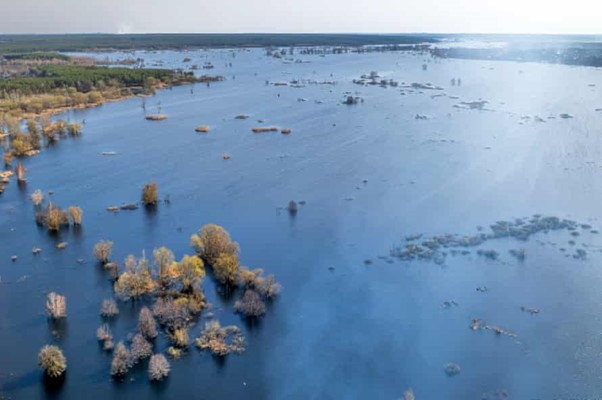
Wetlands and the war in Ukraine – hope amid catastrophe
Besides the tragic loss of human life and destruction of infrastructure, Ukraine’s environment has been another casualty of Russia’s invasion. Nature has suffered due to fires started by munitions and shelling, while the air, water and soil are being polluted by the ongoing war. The threat of radioactive contamination is also a pressing concern. Amidst the tragedy, there is also some hope.
By Henk Zingstra, Associate Expert
Re-flooding the Ukrainian Amazon
The war is directly impacting nature conservation and wetland management. One of the most striking examples is nearby Irpin, a city close to Kyiv. At the end of February 2022, when Russian troops were swiftly approaching, Ukrainian troops defending the capital opened a dam along the Irpin River causing the Irpin floodplains to be inundated. The breaching of the Irpin dam held back the Russian soldiers and tanks, and re-flooded 13,000 hectares (32,000 acres) of wetlands that were drained by the Soviets in the 1960s. The Russian army had to retreat and at least for now, Kyiv is safe from a land invasion.
The Irpin floodplains were once a biodiversity hotspot, a Ukrainian Amazon with vast wetlands composed of bogs, swamps, and marshes, that thrived along riverbanks of thick reed beds and dunes of golden sand. But the floodplains of the Irpin River were drained during Soviet times and the outstanding nature was lost.
Bohdan Prots the Director of the Danube-Carpathian Programme , who also works part-time for the State Museum of Natural History, National Academy of Sciences of Ukraine tells me on a call, “It (the floodplain) was five metres deep in places and full of giant catfish and sturgeon, as well as now-missing wetland bird species and birds of prey like the white-tailed eagle.”
Damming and draining the floodplains on the Irpin (and also Dnipro) River had a catastrophic impact on the ecosystems that once thrived here. Many housing developments were built on the old floodplain, putting further pressure on the dying river ecosystem. Until the outbreak of war a massive new housing development was planned in the floodplains. But with the waters possibly back for good, the future is now uncertain.
Conservationists, including Bohdan, hope that the reflooding will be the start of restoring the original beauty and biodiversity of the floodplains. But before that happens, much work must be done.
According to Bohdan, “Wetlands can’t be restored just like that. Just because the water has returned doesn’t mean we are looking at a new wetland rich in biodiversity. The ecology has been very badly degraded over many years. It would take many years for ecological improvements to be observed. The sudden reflooding of the old Kyiv-Irpin wetlands, which also helped defend Kyiv against the Germans in 1941, is unlikely to have the same ecological benefits as a carefully managed rewetting project would produce.”
Bohdan continues, “Irpin townspeople sacrificed their lives and houses to protect Kyiv. War doesn’t do rewilding – there was no research, and there was no planning or mitigation. The critical stakeholder involvement, like the local community, should not be ignored.”
The Chernobyl Exclusion Zone
The Chernobyl Exclusion Zone is another area where Bohdan and his team ran a restoration project. Because large stretches of the exclusion zone were in a drained state before the war, the chance of wildfire has increased significantly, releasing dust and smoke loaded with radionuclides. The project focused on restoring water in the landscape and increasing firefighting capacities.
And although the Russian army retreated from the Chernobyl area, resuming conservation work is now impossible. Apart from the site being full of landmines, the office equipment was mostly destroyed or looted. Bohdan states that the Russian military was using old maps and had no clue of the radiation levels in the area, and even established a military base in the part of the Exclusion Zone with the highest radiation levels.
The Carpathian Mountains
Last but not least, Bohdan and his team are working in the west of the country in the Carpathians mountains, with a focus on protecting a number of different habitats of old-growth forests and wet meadows, and maintaining the functioning of ecological corridors for large carnivores. Protecting these habitats was already an urgent need in pre-war times due to the over-harvesting of timber. As elsewhere, climate change adds to the threats for these ecosystems.
The Big Picture
In addition to the massive support Ukraine will need to rebuild its infrastructure after the war, it is also clear that it will need significant support to restore the incredible damage done to its environment and biodiversity. According to Bohdan, the large natural and protected areas help to strengthen the defence capacity against invaders; wilderness like forests, rivers, and wetlands are proven obstacles. The diversity of nature contains enormous potential for the protection of national frontiers. We all know that sustainability, conservation, and fostering abundant biodiversity are beneficial to people’s health and food security in the long term. But it can also work as a bulwark against intruding enemies. Who would have thought it?
Henk Zingstra chairs the Eurosite Management Planning Expert Working Group of which Bohdan is one of the members. Henk and Bohdan have known each other since they worked together on a project to introduce the Habitats Directive in the Ukrainian part of the Carpathians (2016-2018) and have remained friends. They met up again in Ukraine in December 2022.
More information:
